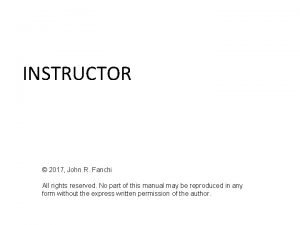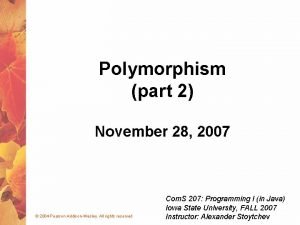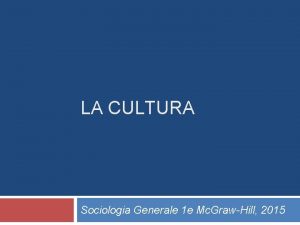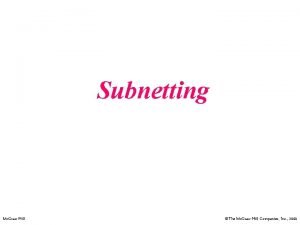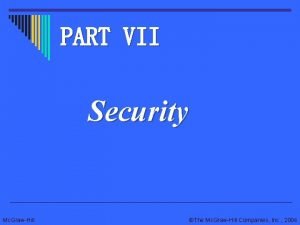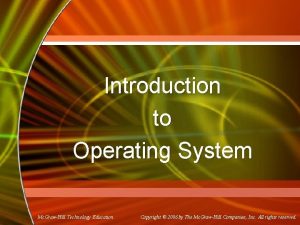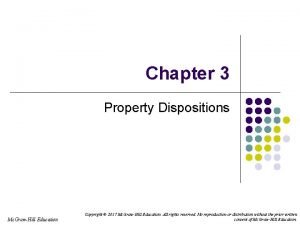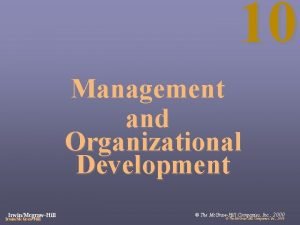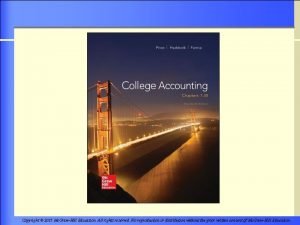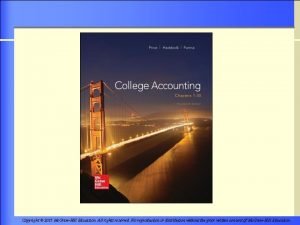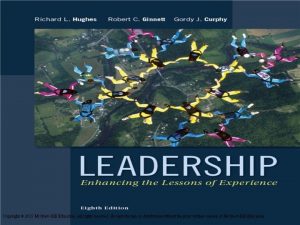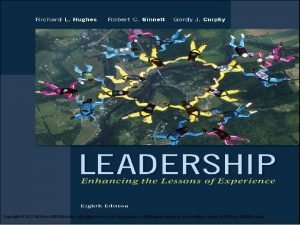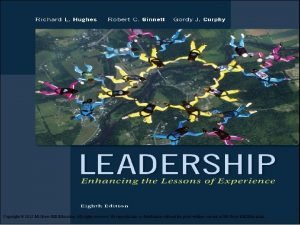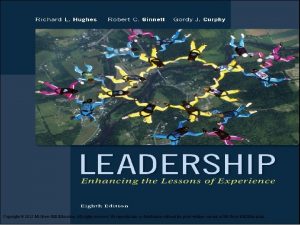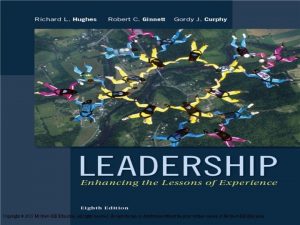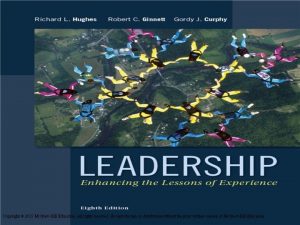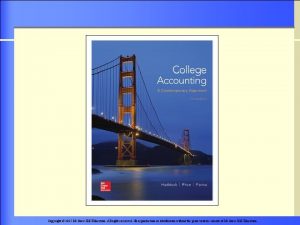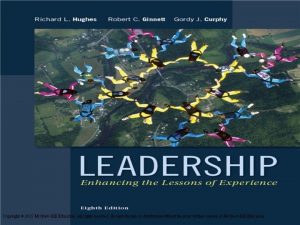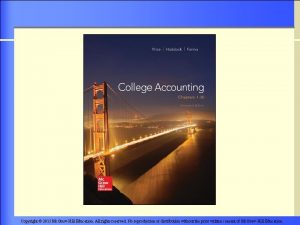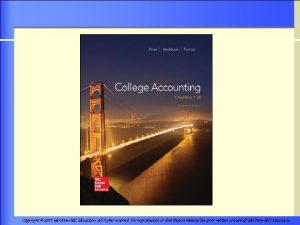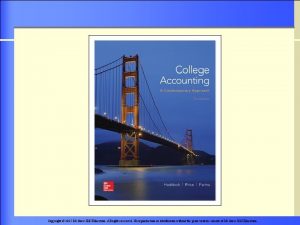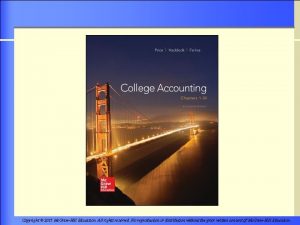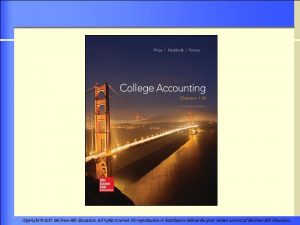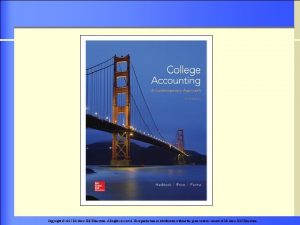Copyright 2015 Mc GrawHill Education All rights reserved





































- Slides: 37

Copyright © 2015 Mc. Graw-Hill Education. All rights reserved. No reproduction or distribution without the prior written consent of Mc. Graw-Hill Education.

Chapter 1 Accounting: The Language of Business Section 1: What Is Accounting? Section Objectives 1 -1 Define accounting. 1 -2 Identify and discuss career opportunities in accounting. 1 -3 Identify the users of financial information. Copyright © 2015 Mc. Graw-Hill Education. All rights reserved. No reproduction or distribution without the prior written consent of Mc. Graw-Hill Education. 1 -2

In running a business, you need answers to questions: How much cash does the business have? How much money do customers owe the business? What is the cost of the merchandise sold? What is the change in sales volume? How much money is owed to suppliers? What is the profit or loss? Copyright © 2015 Mc. Graw-Hill Education. All rights reserved. No reproduction or distribution without the prior written consent of Mc. Graw-Hill Education. 1 -3

Objective 1 -1 Define Accounting QUESTION: What is accounting? ANSWER: Accounting is the process by which financial information about a business is classified, recorded, summarized, interpreted, and communicated to owners, managers and other interested parties. Copyright © 2015 Mc. Graw-Hill Education. All rights reserved. No reproduction or distribution without the prior written consent of Mc. Graw-Hill Education. 1 -4

QUESTION: What are financial statements? ANSWER: Financial statements are periodic reports of a firm’s financial position and operating results. Copyright © 2015 Mc. Graw-Hill Education. All rights reserved. No reproduction or distribution without the prior written consent of Mc. Graw-Hill Education. 1 -5

Objective 1 -2 Identify and discuss career opportunities in accounting Many jobs are available in the accounting profession. Some examples are: Bookkeepers & Accounting Clerks Financial Analysts Financial Managers Copyright © 2015 Mc. Graw-Hill Education. All rights reserved. No reproduction or distribution without the prior written consent of Mc. Graw-Hill Education. 1 -6

Accountants generally work in one of these areas: Public accounting Managerial accounting Governmental accounting Copyright © 2015 Mc. Graw-Hill Education. All rights reserved. No reproduction or distribution without the prior written consent of Mc. Graw-Hill Education. 1 -7

Public accounting firms provide services such as: • Auditing • Tax accounting • Management advisory services Copyright © 2015 Mc. Graw-Hill Education. All rights reserved. No reproduction or distribution without the prior written consent of Mc. Graw-Hill Education. 1 -8

QUESTION: Who is a certified public accountant? ANSWER: A certified public accountant, or CPA, is an independent accountant who provides accounting services to the public for a fee. Copyright © 2015 Mc. Graw-Hill Education. All rights reserved. No reproduction or distribution without the prior written consent of Mc. Graw-Hill Education. 1 -9

QUESTION: What is managerial accounting? ANSWER: Managerial accounting includes a wide range of work carried on by an accountant employed by a single business in industry. Copyright © 2015 Mc. Graw-Hill Education. All rights reserved. No reproduction or distribution without the prior written consent of Mc. Graw-Hill Education. 1 -10

Managerial Accounting, or private accounting, involves working for a single business to: • Establish accounting policies • Provide financial advice to management • Manage the accounting system • Prepare and interpret financial statements • Prepare tax forms and do tax planning • Prepare internal reports for management Copyright © 2015 Mc. Graw-Hill Education. All rights reserved. No reproduction or distribution without the prior written consent of Mc. Graw-Hill Education. 1 -11

QUESTION: What is governmental accounting? ANSWER: Governmental accounting involves keeping financial records and preparing financial reports for a federal, state, or local governmental unit. Copyright © 2015 Mc. Graw-Hill Education. All rights reserved. No reproduction or distribution without the prior written consent of Mc. Graw-Hill Education. 1 -12

Governmental accounting involves keeping financial records and preparing financial reports as part of the staff of federal, state, or local governmental units, such as: • Securities and Exchange Commission (SEC) • Internal Revenue Service (IRS) • Federal Bureau of Investigation (FBI) • Homeland Security (DHS) Copyright © 2015 Mc. Graw-Hill Education. All rights reserved. No reproduction or distribution without the prior written consent of Mc. Graw-Hill Education. 1 -13

Objective 1 -3 Inside The Business Identify the users of financial information Outside The Business l a i nc ts a r Fin epo R Employees Copyright © 2015 Mc. Graw-Hill Education. All rights reserved. No reproduction or distribution without the prior written consent of Mc. Graw-Hill Education. 1 -14

Suppliers Use financial information to: • Assess the firm’s ability to pay its bills • Set a credit limit for the firm Copyright © 2015 Mc. Graw-Hill Education. All rights reserved. No reproduction or distribution without the prior written consent of Mc. Graw-Hill Education. 1 -15

Banks Use financial information to: • Decide whether to make a loan • Determine the terms of the loan Copyright © 2015 Mc. Graw-Hill Education. All rights reserved. No reproduction or distribution without the prior written consent of Mc. Graw-Hill Education. 1 -16

Tax Authorities Use financial information to determine the tax base for: • Income taxes • Sales taxes • Property taxes Copyright © 2015 Mc. Graw-Hill Education. All rights reserved. No reproduction or distribution without the prior written consent of Mc. Graw-Hill Education. 1 -17

Regulatory Agencies and Investors • The Securities and Exchange Commission (SEC) is the federal agency that oversees the financial information of public corporations. • Public corporations are those whose stock is traded on stock exchanges and over-thecounter markets. Copyright © 2015 Mc. Graw-Hill Education. All rights reserved. No reproduction or distribution without the prior written consent of Mc. Graw-Hill Education. 1 -18

Sarbanes-Oxley Act The Act led to a major change in the regulatory environment. The Act was designed as a regulatory crackdown on corporate fraud and corruption. Copyright © 2015 Mc. Graw-Hill Education. All rights reserved. No reproduction or distribution without the prior written consent of Mc. Graw-Hill Education. 1 -19

Customers Use financial information to: • Determine the economic health of the business • Determine the likelihood that the firm will remain in business to provide parts, service, and support Copyright © 2015 Mc. Graw-Hill Education. All rights reserved. No reproduction or distribution without the prior written consent of Mc. Graw-Hill Education. 1 -20

Employees and Unions Use financial information to: Negotiate wages and benefits Monitor profitability of profit-sharing plans Copyright © 2015 Mc. Graw-Hill Education. All rights reserved. No reproduction or distribution without the prior written consent of Mc. Graw-Hill Education. 1 -21

Chapter 1 Accounting: The Language of Business Section 2: Business and Accounting Section Objectives 1 -4 Compare and contrast the three types of business entities. 1 -5 Describe the process used to develop generally accepted accounting principles. Copyright © 2015 Mc. Graw-Hill Education. All rights reserved. No reproduction or distribution without the prior written consent of Mc. Graw-Hill Education. 1 -22

Objective 1 -4 Compare and contrast the three types of business entities Three major legal forms of a business entity: Partnership Sole Proprietorship Corporation Copyright © 2015 Mc. Graw-Hill Education. All rights reserved. No reproduction or distribution without the prior written consent of Mc. Graw-Hill Education. 1 -23

QUESTION: What is a sole proprietorship? ANSWER: A sole proprietorship is a business entity owned by one person who is legally responsible for the debts and taxes of the business. Copyright © 2015 Mc. Graw-Hill Education. All rights reserved. No reproduction or distribution without the prior written consent of Mc. Graw-Hill Education. 1 -24

Sole Proprietorship Ownership Partnership Corporation 1 owner Ends when owner: • is unable to carry on, • dies, or • closes the firm Life Responsibility for business debts if firm is unable to pay Owner Copyright © 2015 Mc. Graw-Hill Education. All rights reserved. No reproduction or distribution without the prior written consent of Mc. Graw-Hill Education. 1 -25

QUESTION: What is a partnership? ANSWER: A partnership is a business entity owned by two or more people who are legally responsible for the debts and taxes of the business. Copyright © 2015 Mc. Graw-Hill Education. All rights reserved. No reproduction or distribution without the prior written consent of Mc. Graw-Hill Education. 1 -26

Sole Proprietorship Ownership 1 owner Ends when owner: • is unable to carry on, • dies, or • closes the firm Life Responsibility for business debts if firm is unable to pay Owner Partnership Corporation 2 or more owners Ends when partner(s): • withdraws, • dies, or • closes the firm Partners individually and jointly Copyright © 2015 Mc. Graw-Hill Education. All rights reserved. No reproduction or distribution without the prior written consent of Mc. Graw-Hill Education. 1 -27

Typical partnerships Professional services such as: Accounting Firms Medical Practices Dental Practices Architectural Firms Law Firms Copyright © 2015 Mc. Graw-Hill Education. All rights reserved. No reproduction or distribution without the prior written consent of Mc. Graw-Hill Education. 1 -28

Partners must agree upon: • Amount each partner will contribute to the business. • Percentage of ownership of each partner. • Share of profits of each partner. • Duties each partner will perform. • Debts - the responsibility each partner has for the partnership’s debts. Copyright © 2015 Mc. Graw-Hill Education. All rights reserved. No reproduction or distribution without the prior written consent of Mc. Graw-Hill Education. 1 -29

QUESTION: What is a corporation? ANSWER: A corporation is a publicly or privately owned business entity that is separate from its owners and has a legal right to own property and do business in its own name; stockholders are not responsible for the debts or taxes of the business. Copyright © 2015 Mc. Graw-Hill Education. All rights reserved. No reproduction or distribution without the prior written consent of Mc. Graw-Hill Education. 1 -30

Ownership Sole Proprietorship Partnership 1 owner 2 or more Ends when owner: • is unable to carry on, • dies, or • closes the firm Life Responsibility for business debts if firm is unable to pay Owner Ends when partner(s): • dies, • close the firm • withdraws Partners individually and jointly Corporation Can be one or thousands Continues indefinitely; ends when: • business goes bankrupt • stockholders vote to liquidate Stockholders can lose only the amount invested Copyright © 2015 Mc. Graw-Hill Education. All rights reserved. No reproduction or distribution without the prior written consent of Mc. Graw-Hill Education. 1 -31

QUESTION: What is stock? ANSWER: Stock is issued in the form of stock certificates, and represents the ownership of the corporation. Copyright © 2015 Mc. Graw-Hill Education. All rights reserved. No reproduction or distribution without the prior written consent of Mc. Graw-Hill Education. 1 -32

Important Distinction For accounting purposes, all forms of business entities are considered separate entities. However, the corporation is the only form of business that is a separate legal entity. Copyright © 2015 Mc. Graw-Hill Education. All rights reserved. No reproduction or distribution without the prior written consent of Mc. Graw-Hill Education. 1 -33

QUESTION: What is the separate entity assumption? ANSWER: The separate entity assumption is the concept of keeping a firm’s financial records separate from the owner’s personal financial records. Copyright © 2015 Mc. Graw-Hill Education. All rights reserved. No reproduction or distribution without the prior written consent of Mc. Graw-Hill Education. 1 -34

Describe the process used to develop Objective 1 -5 generally accepted accounting principles QUESTION: What are generally accepted accounting principles (GAAP)? ANSWER: Generally accepted accounting principles (GAAP) are accounting standards developed and applied by professional accountants. Copyright © 2015 Mc. Graw-Hill Education. All rights reserved. No reproduction or distribution without the prior written consent of Mc. Graw-Hill Education. 1 -35

QUESTION: What is an auditor’s report? ANSWER: An auditor’s report accompanies an independent accountant’s audit or review of a firm’s financial statements. Copyright © 2015 Mc. Graw-Hill Education. All rights reserved. No reproduction or distribution without the prior written consent of Mc. Graw-Hill Education. 1 -36

Thank You for using College Accounting, 3 rd Edition Haddock • Price • Farina Copyright © 2015 Mc. Graw-Hill Education. All rights reserved. No reproduction or distribution without the prior written consent of Mc. Graw-Hill Education. 1 -37
 Copyright 2015 all rights reserved
Copyright 2015 all rights reserved Copyright © 2015 all rights reserved
Copyright © 2015 all rights reserved Dell all rights reserved copyright 2009
Dell all rights reserved copyright 2009 Copyright © 2018 all rights reserved
Copyright © 2018 all rights reserved 2012 pearson education inc
2012 pearson education inc Pearson education inc. all rights reserved
Pearson education inc. all rights reserved Pearson education inc. all rights reserved
Pearson education inc. all rights reserved Copyright 2010 pearson education inc
Copyright 2010 pearson education inc 2010 pearson education inc
2010 pearson education inc All rights reserved example
All rights reserved example All rights reserved sentence
All rights reserved sentence Creative commons vs all rights reserved
Creative commons vs all rights reserved Confidential all rights reserved
Confidential all rights reserved Sentinel value
Sentinel value Microsoft corporation. all rights reserved.
Microsoft corporation. all rights reserved. Microsoft corporation. all rights reserved.
Microsoft corporation. all rights reserved. Microsoft corporation. all rights reserved
Microsoft corporation. all rights reserved Warning all rights reserved
Warning all rights reserved Siprop
Siprop All rights reserved formula
All rights reserved formula Warning all rights reserved
Warning all rights reserved Confidential all rights reserved
Confidential all rights reserved Microsoft corporation. all rights reserved
Microsoft corporation. all rights reserved 2017 all rights reserved
2017 all rights reserved Confidential all rights reserved
Confidential all rights reserved Confidential all rights reserved
Confidential all rights reserved R rights reserved
R rights reserved Rights reserved
Rights reserved Education for all 2000 2015 achievements and challenges
Education for all 2000 2015 achievements and challenges Grawhill
Grawhill Grawhill
Grawhill 作業管理精簡版13版解答
作業管理精簡版13版解答 Grawhill
Grawhill Mc graw hill
Mc graw hill Mc grawhill
Mc grawhill Grawhill
Grawhill Mc grawhill
Mc grawhill Grawhill
Grawhill


























